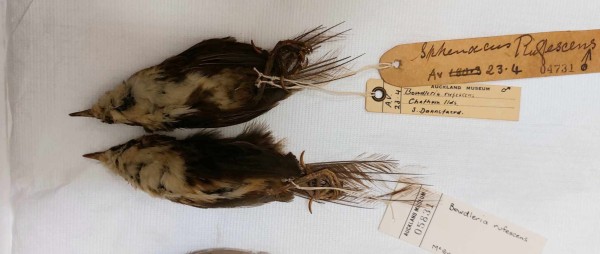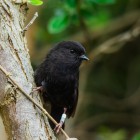
Blog and news
Lost Species: Chatham Island Fernbird
It’s Remembrance Day for Lost Species*, and we’re remembering the Chatham Island fernbird. Although the other fernbirds are at risk, this small songbird is the only one to have become extinct.
Fernbirds (mātātā) are small, brownish songbirds with long tails, endemic to Aotearoa. They tend to be found in low wetland vegetation. Well-camouflaged, the five subspecies still around today are more often heard than they are seen. The sixth can only been seen in illustrations and some museum collections.

CI Fernbird. By John Gerrard Keulemans - Extinct birds. By Lionel Walter Rothschild, 2nd Baron Rothschild (8 February 1868 – 27 August 1937).
The only extinct fernbird
The Chatham Island fernbird was similar to the other fernbird species, with long tails that often became frayed, giving them a charmingly tatty appearance. However, the Chatham fernbird lacked the speckling underneath common to other fernbirds, giving the underside a cleaner, crisper look. Its reddish, or rufous, colouration above gave it its scientific name - Poodytes rufescens.
Little is known about its habits, or habitats, but it was described as occurring in low stunted forests, and like other fernbird species did not readily venture far from cover. The call was described as a “peculiar whistle, very like that which a man would use in order to attract the attention of another at some distance” (Travers and Travers 1873).
Formerly, it was properly common – fossil records show it was found all over the Chathams archipelago. Its disappearance from Rēkohu/Wharekauri and Pitt can be attributed, like so many of our species, to habitat loss and introduced predators. By 1872, it was confined to Mangere/Maung’Re Island.
However, rabbits had been introduced to Mangere/Maung’Re. To control the rabbit population, cats were introduced – resulting in the total extinction of the fernbird. The last specimens were collected in January 1895, shortly after the release of cats.
The species’ extinction wasn’t helped by overzealous bird collectors, who targeted rare species to sell to European and America collectors.

Fernbird specimens in Auckland Museum, courtesy Auckland Museum and Peter de Lange.
Extinct birds of the Chathams
As well as the fernbird, a number of other bird species have become extinct since the arrival of humans in the Chatham Islands. This includes a bellbird, a penguin, several flightless rails, a swan, a duck, and a merganser.
Remembrance Day for Lost Species is an opportunity to share the stories of species and habitats driven to extinction by human activity. A bit of a downer, perhaps, but an important downer. As well as remembering what’s gone, it reminds us that how humans choose to live does have a measurable impact on the world around us. Sometimes that impact is permanent.

Chatham Island fernbird specimen. By Auckland Museum, CC BY 4.0.
References
Thanks to Mike Bell and Peter de Lange for helping prepare this blog.
Travers & Travers 1873
* We’re not even sure if people do Remembrance Day for Lost Species anymore, which would kind of make this a Remembrance for Remembrance Day for Lost Species blog. Meta as.


